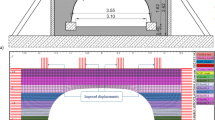Abstract
The installation of driven piles in urban areas encounters various challenges due to several installation requirements concerning vibration, noise pollution, adjacent structure protection, and access to heavy traffic areas. Novel helical piles resolve these challenges and reduce soil disturbance. The present study conducts a field study of helical, self-expanded, drilled displacement steel piles, and driven piles with an embedment depth of 3.2 m. The piles were subjected to static compressive loading tests. It was found that the helical and self-expanded piles had approximately 70% higher bearing capacities than the driven pile at a displacement as large as 5% of the pile diameter and can be efficient and effective alternatives to driven piles in urban and coastal constructions. Then, numerical simulations were performed using the finite element method to explore the effects of soil layers on the bearing capacity of helical piles and the soil failure mechanism. It was found that soil layers significantly affected the bearing capacity of a helical pile and would change the cylindrical failure mechanism into the individual failure mechanism. Furthermore, a rise in the clayey soil depth could substantially influence the bearing capacity of a helical pile.















Similar content being viewed by others
References
Perko HA (2009) Helical piles: a practical guide to design and installation. Helical Piles A Pract Guid Des Install. https://doi.org/10.1002/9780470549063
Mitchell A (1848) On submarine foundations; particularly the screw pile and moorings. Min Proc Inst Civ Eng 7:108–132. https://doi.org/10.1680/imotp.1848.24220
Di Bernardo G (2012) Helical pile Deck foundation. New Jersey Deck Boulder, USA
Spagnoli G (2017) A CPT-based model to predict the installation torque of helical piles in sand. Mar Georesour Geotechnol 35(4):578–585. https://doi.org/10.1080/1064119X.2016.1213337
de Hollanda C, Tsuha C, Aoki N (2010) Relationship between installation torque and uplift capacity of deep helical piles in sand. Can Geotech J 47(6):635–647. https://doi.org/10.1139/T09-128
Hambleton J, Stanier S, Gaudin C, odeshkejoei K (2014) Analysis of installation forces for helical piles in clay. Aust Geomech J 49(4):73–79
Nabizadeh F, Choobbasti A (2017) Field study of capacity helical piles in sand and silty clay. Transp Infrastruct Geotechnol 4(1):3–17. https://doi.org/10.1007/s40515-016-0036-0
Elsherbiny Z, El Naggar M (2013) Axial compressive capacity of helical piles from field tests and numerical study. Can Geotech J 50(12):1191–1203. https://doi.org/10.1139/cgj-2012-0487
Tang C, Phoon K (2020) Statistical evaluation of model factors in reliability calibration of high-displacement helical piles under axial loading. Can Geotech J 57(2):246–262. https://doi.org/10.1139/cgj-2018-0754
Sakr M (2011) Installation and performance characteristics of high capacity helical piles in cohesionless soils. J Deep Found Inst 5(1):39–57. https://doi.org/10.1179/dfi.2011.004
Malik A, Kuwano J, Tachibana S, Maejima T (2017) End bearing capacity comparison of screw pile with straight pipe pile under similar ground conditions. Acta Geotech 12(2):415–428. https://doi.org/10.1007/s11440-016-0482-4
Li W, Deng L (2019) Axial load tests and numerical modeling of single-helix piles in cohesive and cohesionless soils. Acta Geotech 14(2):461–475. https://doi.org/10.1007/s11440-018-0669-y
Livneh B, El Naggar M (2008) Axial testing and numerical modeling of square shaft helical piles under compressive and tensile loading. Can Geotech J 45(8):1142–1155. https://doi.org/10.1139/T08-044
Sprince A, Pakrastinsh L (2010) Helical pile behaviour and load transfer mechanism in different soils. In: 10th modern building materials, structures and techniques pp 1174–1180
Nowkandeh M, Choobbasti A (2021) Numerical study of single helical piles and helical pile groups under compressive loading in cohesive and cohesionless soils. Bull Eng Geol Environ 80(5):4001–4023. https://doi.org/10.1007/s10064-021-02158-w
Alwalan M, El Naggar M (2020) Finite element analysis of helical piles subjected to axial impact loading. Comput Geotech. https://doi.org/10.1016/j.compgeo.2020.103597
Shojaei E, Eslami A, Ganjian N (2021) Self-expanded piles: a new approach to unconventional piles development. Mar Georesour Geotechnol 39(1):115–128. https://doi.org/10.1080/1064119X.2019.1679924
Ahmadi H, Eslami A, Arabani M (2015) Characterization of sedimentary Anzali Sand for static and seismic studies purposes. Int J Geogr Geol 4(10):155–169
ASTM D1143/D1143M-07. Standard. Test methods for deep foundations under static axial compressive load. ASTM International
Eslami A, Fellenius B (1997) Pile capacity by direct CPT and CPTu methods applied to 102 case histories. Can Geotech J 34(6):886–904. https://doi.org/10.1139/t97-056
Randolph M (2003) Load transfer analysis of axially loaded piles, RATZ
Author information
Authors and Affiliations
Corresponding author
Ethics declarations
Conflicts of interest
The authors have no conflicts of interest to declare that are relevant to the content of this article.
Ethical approval
This article does not contain any studies with human participants or animals performed by any of the authors.
Informed consent
For this type of study, formal content is not required.
Rights and permissions
Springer Nature or its licensor (e.g. a society or other partner) holds exclusive rights to this article under a publishing agreement with the author(s) or other rightsholder(s); author self-archiving of the accepted manuscript version of this article is solely governed by the terms of such publishing agreement and applicable law.
About this article
Cite this article
Seifi, S., Nayeri, A. & Lajevardi, S.H. Field and numerical studies on bearing capacity of helical screw piles in Caspian Sea coast soil. Innov. Infrastruct. Solut. 8, 54 (2023). https://doi.org/10.1007/s41062-022-01019-z
Received:
Accepted:
Published:
DOI: https://doi.org/10.1007/s41062-022-01019-z




